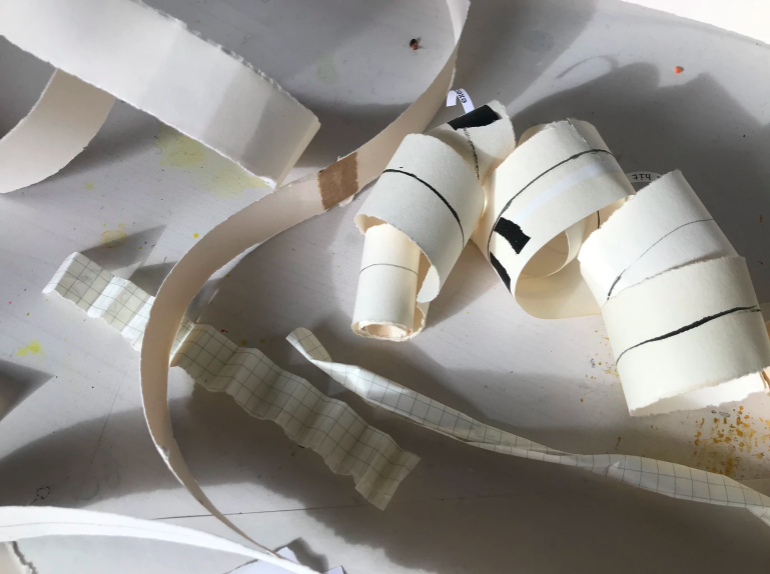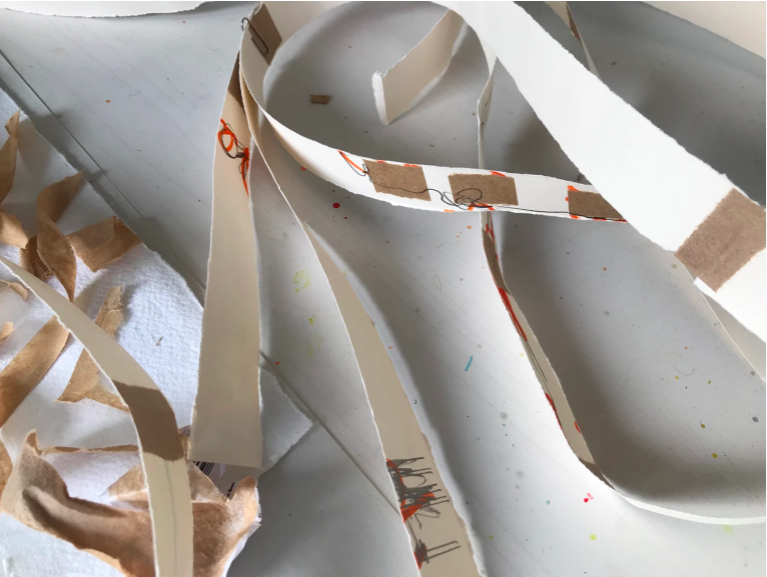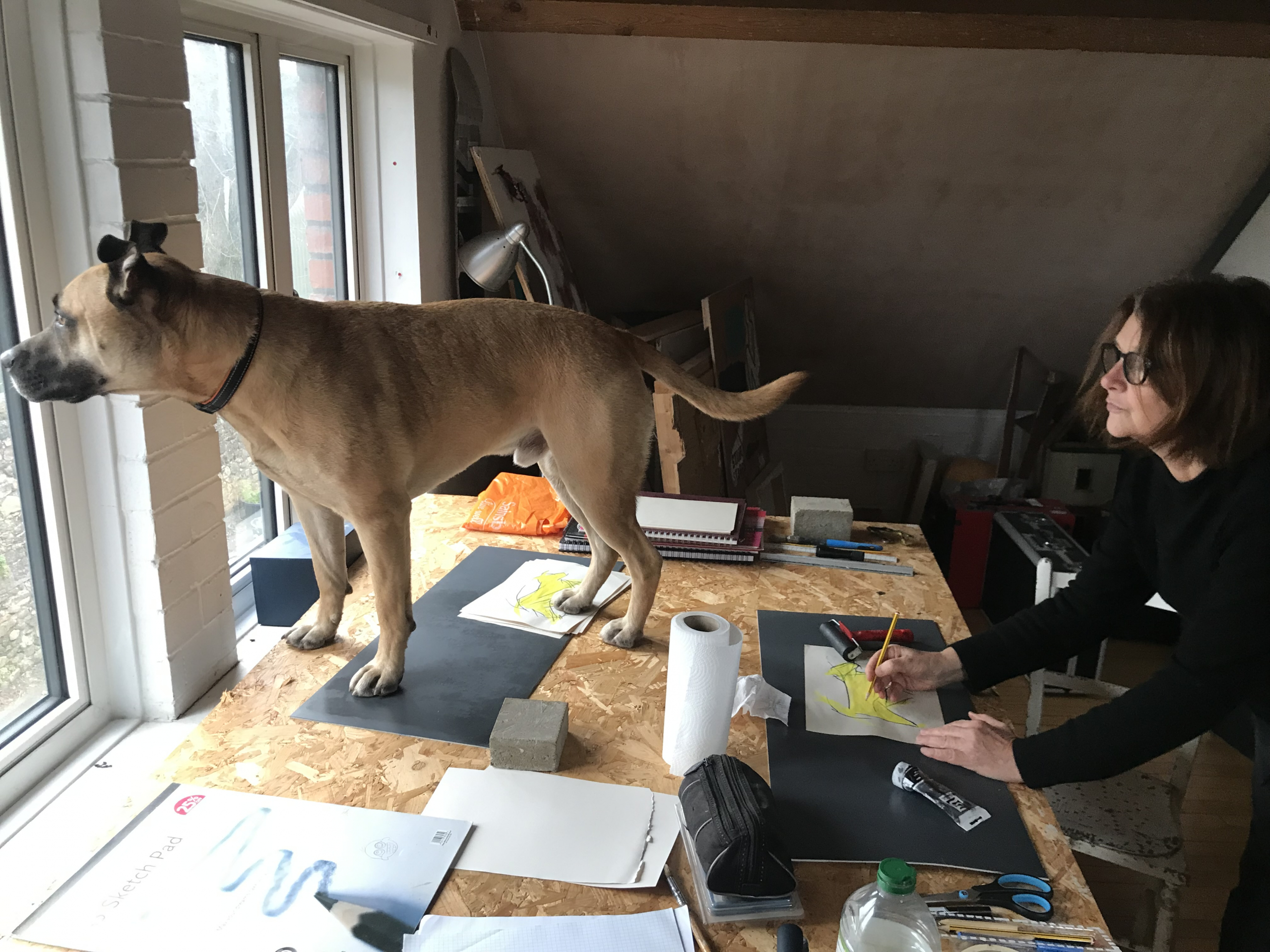“It is time for a complete redefinition of how we do all that happens around visual practice”.
Bella Kerr Q&A with R&J Projects in March 2021
R&J:
What are you working on at the moment?
BK:
With Lyndon Jones, I have started work on a second series of short films about architecture in Wales for the RSAW. At this stage we are talking to potential places and presenters, and hope to write scripts and record voice-overs over the next couple of months and film in the late spring and early summer (as Covid restrictions allow). The films are essentially documentary and unlike anything I have ever made – it is good to be learning.
I’m also working with a group of artists on a project called Finding Beuys. Joseph Beuys was born 100 years ago and we are looking at his practice to evolve a way of working together towards something – as yet unknown – later in the year.
I recently attended an online writing course with Arvon. I have been using words in my visual work for some time, and over the years have produced quite a lot of academic, admin and art blah writing, and wanted to explore other approaches and forms. I meet with others from the course once a month and we share what we have been writing – poems, shorts stories, autobiography.
I try to draw in my studio everyday and write somewhere else.
R&J:
Are you an artist who prefers solitude or togetherness to thrive? Or do you need a balance of both? Have events over the past year and ongoing situation affected you? How have you remained positive?
BK:
I left teaching less than a year before lockdown and so stepped back quite abruptly from daily contact with a large number of people. Listing my activities above it seems evident that I thrive on collaboration and conversation, but I have enjoyed having time for solitude; spent working, reading or doing very little.
Most activities involving others are via email or Zoom at present, which is in some ways difficult, and in others quite liberating, as it permits otherwise unlikely meetings across greater geographical distances, without the cost or stress of travel.
R&J:
What are you reading, listening to, watching right now/recently?
BK:
I have been able to read a lot over the past year – but I have always read, on the train to work or anywhere and whenever I could.
I read Hilary Mantel during the first lockdown, as many others did, and was similarly impressed by the parallels with our current experience of plague and government. David Grauber’s ‘Debt’ is a giant academic text and I tackled it in small portions over many weeks. His long view into history puts everything into perspective. I am currently reading short stories by Lucia Berlin (A Manual for Cleaning Women) – sent by a clever friend with extensive book knowledge – and they are brilliant.
Caring for aging relatives has directed me to Atul Gawande, Kathryn Mannix and Rachel Clarke, writing on old age, illness and death. This reading has come a little late in relation to my parents, but is very important to how I – we – must start to think about the later stages of life, for ourselves and others.
I am trying to learn Italian and so I’m enjoying gentle Italian film comedies such as Rose Island, which is also an important and interesting true story. Channel 4 News is a regular watch for tough interviews, competent voices and in-depth investigations.
I use Radio 4 to keep me at my desk when drawing – it allows me to disengage my brain a little from drawing while I pick up scraps and threads of information – and fills my head with a soggy cloud of middle-class sensibleness.
R&J:
Do you have a favourite project or piece of work of your own, or ideas you return to?
BK:
I have recently found some notes in old sketchbooks which show me that I have been thinking about the same things forever. The arrangement of objects in space – large things in a room, small things on a table or across the city, words on a page – is really all that I do. The work is shaped by ideas, but I also intend compelling visual or physical presence. The bronze objects I made with Lee Odishow (for my residency in Venice in a house for homeless men) had immense physical power. I hope that they exist into a long future, detached from their origins; inexplicable, small, weighty comforts.

R&J:
Are there peers or an artist who you particularly identify with or whose work you relate to? What would be your dream collaboration?
BK:
I have had ‘crushes’ on many artists and writers over the years – a longer or shorter term interest in work that has said something to me – and they all sit in my thoughts – and on my bookshelves.
In lockdown, I am happy to be relieved of seeing a lot of art – it had become a duty – but I am thinking about Beuys and how seeing his drawings for the first time when I was a student was immensely important to me.
Collaboration can be very productive, but it is also hard. I’m not sure what I have or want to offer right now, but I am committed to current collaborations and would welcome them in the future if they evolve. For example, I have been emailing with someone in Rhode Island whose daughter is applying to study in the UK, and we might find a way to work together in the future.
R&J:
Do you rely on a support network of friends, colleagues, for advice, feedback, exchange of ideas, critical support?
BK:
Yes – informally, on a one-to-one basis with friends who are artists – and via the groups I am part of. I respond to requests for advice or references, or attend meetings as part of voluntary work, at least once a week. This is in the main a reciprocal process with ex-students, old friends, colleagues or organisations.
It would be good to have a ‘tutorial’. I feel as if I am back at a beginning and need some conversations about my work. Most of us need to be challenged and encouraged in whatever we do. It is difficult but important to find or create situations where this can happen.
R&J:
What advice would you give to younger or emerging artists?
BK:
It is time for a complete redefinition of how we do all that happens around visual practice. That’s a big ask for a new generation – I hope that they are onto it already. Existing institutions are corrupt and/or calcified and art education has been hijacked by universities who think they are doing ‘business’. A lot of people need to step back. My generation capitulated to much that is worthless or damaging, in many ways – sorry.


R&J:
What has been the most rewarding aspect of your practice?
BK:
My own education and teaching were important. Collaborations, residencies and exhibitions were often connected to my teaching practice, with the hope that they could inform each other and that I could create communication rather than contradiction across what are often seen as opposed activities.
“I have been permitted this recent period for consideration of what I have done and might do.
It has been immensely valuable”.
R&J:
Do you have a favourite object within a collection or museum/archive that you return to or find yourself referencing over time?
BK:
I worked in the bookshop at the British Museum for many years and had the privilege of the galleries before and after the crowds; private viewings of case upon case of small, ancient bronze and clay objects that spoke of everyday actions, beliefs and how hands shape materials.
R&J:
Is there something you wish you had done – or still plan to do?
BK:
Of course – in terms of my practice and in other parts of my life. I have been permitted this recent period for consideration of what I have done and might do. It has been immensely valuable and I have found a happiness similar to my experience as a making, drawing, thinking child. This may produce something, or perhaps ‘nothing’ – a thoughtful lack of destructive activity?
You can purchase or order editioned prints by Bella Kerr HERE



